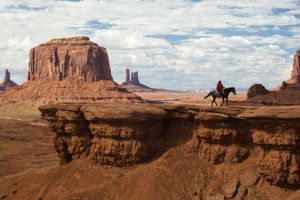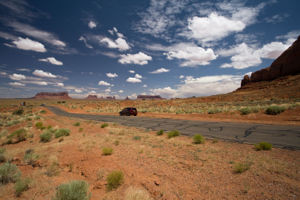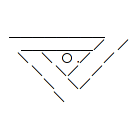Monument Valley
|
Mittens
This page is about mittens. |
|
Too fucking long.
This article is too long. Where did you copy it from? |
Monument Valley is located on the southern border of Utah with northern Arizona (around 36°59′N, 110°6′W). The valley lies within the range of the Navajo Nation Reservation, and is accessible from U.S. Highway 163. The Navajo name for the valley is Tsé Bii' Ndzisgaii (Valley of the Rocks). It is remarkable for its twin buttes, called "the Mittens".
Contents
Geology
The area is part of the Colorado Plateau. The floor is largely Cutler Red siltstone or its sand deposited by the meandering rivers that carved the valley. The valley's vivid red color comes from iron oxide exposed in the weathered siltstone. The darker, blue-gray rocks in the valley get their color from manganese oxide.
The buttes are clearly stratified, with three principal layers. The lowest layer is Organ Rock shale, the middle de Chelly sandstone and the top layer is Moenkopi shale capped by Shinarump siltstone. The valley includes large stone structures including the famed Eye of the Sun.
Between 1948 and 1967, the southern extent of the Monument Upwarp was mined for uranium, which occurs in scattered areas of the Shinarump siltstone; vanadium and copper are associated with uranium in some of these deposits.
Iconic imagery
The Valley in media
|
( ゚ ヮ゚)
This section is about Mittens. |
The twin buttes of the Valley ("the Mittens"), the "Totem Pole" (although the Navajo did not actually build totem poles), and the Ear of the Wind arch, among other features, have developed iconic status. They have appeared in many television programs, commercials, and Hollywood movies, especially Westerns.
Film
Director John Ford's 1939 film Stagecoach, starring John Wayne, has had an enduring influence in making the Valley famous. After that first experience, Ford returned nine times to shoot Westerns — even when the films were not set in Arizona or Utah (see The Searchers, set in Texas, but filmed here). A popular lookout point is named in his honor as "John Ford Point." It was used by Ford in a scene from The Searchers where an American Indian village is attacked.
- The Stanley Kubrick film 2001: A Space Odyssey features footage of Monument Valley. This footage is used as the surface of an alien planet to which protagonist Dave Bowman travels through a stargate.
- 1969's counter-culture classic Easy Rider includes some footage of Monument Valley towards its beginning.
- Sergio Leone's Once Upon a Time in the West, although shot for the most part in Spain and Italy, features two scenes shot on location in Monument Valley.
- Clint Eastwood's movie The Eiger Sanction was partly filmed in Monument Valley and both Clint Eastwood and George Kennedy were filmed on top of the "Totem Pole", which has been off-bounds to climbers since the movie was filmed here.
- During the 'Sorter shoot-out' scene in Guy Ritchie's 2005 film, Revolver, there is a picture of Monument Valley on the wall behind where Dorothy Macha's henchmen have parked their cars outside the house of Jake Green's elder brother.
- In Back to the Future III, Marty McFly drives from 1955 to 1885 from a drive-in theatre set at the Valley's base.
- In National Lampoon's Vacation the Griswold's station wagon falls apart in the Valley.
- In Forrest Gump, Forrest ends his cross-country run here. He is running north on U.S. Route 163 before he stops running.
- Godfrey Reggio's documentary Koyaanisqatsi features footage of Monument Valley.
- Ridley Scott's 1991 film Thelma & Louise features some shots of Monument Valley, as well as Canyonlands National Park, in its latter half.
- The opening shots of Mission: Impossible II feature Tom Cruise climbing in Monument Valley.
Television
- The implied association with John Wayne's tough, macho character made the buttes a natural choice as the background for the Marlboro Man in the marketing of Marlboro-brand cigarettes from the 1950s.
- In the 1980s American action/espionage television series Airwolf, a hollowed butte is portrayed as the secret hiding place ("The Lair") of the eponymous high-tech military helicopter. Monument Valley is renamed the "Valley of the Gods" in this series. The actual Valley of the Gods is a few miles north in Utah. The shots of The Lair were actually a mix of matte paintings and shots from three locations within close proximity of each other.
- The MacGyver episode "Eagles" (Season 2, Episode 8) has shots in the Valley. MacGyver is gathering eggs from an eagle's nest on top of a butte.
- The Dutch clown Bassie, of the duo Bassie en Adriaan, performed a rain dance in front of The Three Sisters in their Dutch television series.
- In the made-for-TV movie 10.5: Apocalypse, Monument Valley is flooded from seismic activity.
Music
- The 2003 Led Zeppelin DVD features the West Mitten of Monument Valley on the cover.
- The video for "I Disappear" by Metallica was partially shot in Monument Valley. The song was featured on the soundtrack to MI:2.
- French band Air's 2001 album, 10 000 Hz Legend, features Monument Valley on its cover and throughout the LP's artwork.
- Garth Ennis's Preacher series of comic books features a scene in which the Valley is destroyed by a massive nuclear weapon in an attempt to destroy the Saint of Killers.
Computer
- There is stage that features Monument Valley in the video game Tekken
- The video game AeroWings for the Dreamcast console has a stage set in Monument Valley.
- In the video game The King of Fighters '96, the Art of Fighting Team stage is set in Monument Valley.
- The Playstation 3 video game Motorstorm is a racing game set in Monument Valley.
- A Monument Valley photo was used in Windows Vista Beta 2 as wallpaper.
Tourism
While state highways traverse the valley, the most scenic locations are within Monument Valley Navajo Tribal Park, a Navajo Nation equivalent to a national park. Monument Valley is part of the Grand Circle, which includes the Grand Canyon, Mesa Verde, Bryce Canyon National Park, Zion Canyon National Park, Capitol Reef, Natural Bridges, Hovenweep, Arches National Park, and many other attractions.
There are various hotels and motels within about 5-30 miles of Monument Valley, but rooms are often hard to find during the peak tourist season (between May and October). Also available are various Bed and Breakfast establishments, some of which allow guests to sleep in traditionally built Navajo hogans. There are also camping facilities available.
Guided tours of the park and Mystery Valley (a part of Monument Valley where visitors cannot go without a guide) are available. The fee for tours varies between about $40 and $100 per person depending on the services provided and route. Horseback rides are also available from various establishments both inside the park and in the general area, and rates vary widely depending on the length of the ride. Rides may be only an hour, or overnight camping trips. .
Visitors can also pay an access fee and drive through the park on a 17-mile dirt road (a 2-3 hour trip). A visitor center, and small convenience/souvenir shop stands on the rim of the valley, and includes a restaurant. Since Monument Valley is on tribal land, it is not part of the U.S. National park system, so it is not marked on many road maps as prominently as are National Parks, and on some maps it is not marked at all.
External links
- Monument Valley Navajo Tribal Park website
- Map of Monument Valley
- American Southwest Guide
- Monument Valley Trail Rides
- Detailed geological guide
- Energy Information Administration notes on uranium mining and its decommissioning
- Monument Valley Photos - CapturedLights.com
- Photos of Monument Valley - Terra Galleria
- IMDb list of movies with scenes in Monument Valley
- Monument Valley Pictures at Monument Gallery
Gallery
East Mitten and West Mitten Buttes









